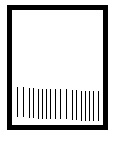
Itís not what you think it is.
Stitch watermarks occur on many different stamps. They occur on US issues as well as stamps from other countries. This may sound confusing, but stitch watermarks occur on stamps that have no other watermark. Thatís right. Some Unwatermarked stamps can still have a stitch watermark. Confused? Here is an explanation.
A stitch watermark is unintentional. It occurs from the joining of the ends of the wire mesh belt used in the paper making process. Briefly, wood pulp that is being made into paper is placed on a wire mesh. While on the mesh, the water drains from the pulp leaving the pulp fibers behind. The pulp fibers bond and eventually they are transformed into paper.
The ends of the wire mesh are stitched together to form a continuous belt. In some circumstances, the stitches leave a slight thin in the paper (just like a watermark). Hence the term ďstitch watermarkĒ
Most stitch watermarks are faint. Itís unusual to find one that is prominent. Under normal circumstances, stitch watermarks donít show up. Only when the stitches are a little loose (or some other situation) do they appear on the paper.
Are stitch watermarks rare? No. They are uncommon and an unusual side effect of the papermaking process. Some collectors think of stitch watermarks as a freak or oddity among normal stamps.
What does a stitch watermark look like? Unfortunately, I donít have a good illustration that will reproduce well here. They vary a little in size and shape. However, they are generally a series of short parallel lines that are a few millimeters long. They are evenly spaced. There can be as many as a dozen or so hash marks on the stamp. Sometimes only a few of the hash marks show though. Shown here is my poor attempt to illustrate what a stitch watermark looks like from the back of a stamp.
What are they worth? The Scott catalog doesnít list them because they are so uncommon. And they are unrelated to the stamp production process itself. Some collectors like the stitch watermarks and collect them. In my opinion, most stitch watermarks are worth a small premium over the normal value of the stamp. If you find a stitch watermark that is unusually prominent or if it is on a scarce stamp (say, on Scott #72 instead of Scott #65), then the premium price is a little more.
Finding a stitch watermark is challenging because they are uncommon. A bottle of watermark fluid and hundreds (thousands?) of stamps could provide endless hours of fun trying to locate one.
